As an Amazon Associate, I earn from qualifying purchases at no extra cost to you.
How to Reset VSC on Toyota Highlander Easily at Home
You are driving your Toyota Highlander and suddenly the VSC light turns on. It can be confusing and even scary when this happens. But do not worry — resetting the VSC (Vehicle Stability Control) system is actually simple and can be done at home. In this article, you will learn exactly how to reset VSC on Toyota Highlander without any tools or special skills.
Turn Off and Restart the Engine
One of the first things you should try is simply turning off and restarting your Toyota Highlander. This may sound too easy, but it works more often than you think. The VSC light can come on just because of a small glitch. When you turn off the engine, it gives the car’s computer a chance to refresh.
Start by stopping your vehicle in a safe area. Make sure the engine is fully off and remove the key or push the stop button. Then, wait for about 2 to 5 minutes. This gives time for the system to shut down properly. After that, start the engine again and check the dashboard. Sometimes, the VSC light will turn off by itself.
If the light stays on, do not panic. It could be that the system is still detecting a small issue or it needs a manual reset. But before going deeper, always try this simple trick. It can save you time and effort.
In some cases, even if the light goes off, you should keep an eye on it. If it comes back later, there may be something deeper going on, and you will want to follow more steps. But for many people, this first solution is enough.
- Turn off the engine completely
- Wait for 2 to 5 minutes
- Restart the engine and check dashboard
- Light may turn off by itself
- If it comes back, try other steps
Press and Hold the VSC Button
Most Toyota Highlanders come with a VSC button. This button is usually found near the gear shift, or sometimes on the dashboard, depending on the model year. It's a small button, usually labeled as 'VSC' or 'VSC OFF'.
To reset the system using this button, follow these steps. First, make sure your Highlander is parked and the engine is running. Now, press and hold the VSC button. Keep holding it for about 5 to 10 seconds. You may notice the VSC light on the dashboard start to blink or go off. That's a sign that the system is resetting.
If the light turns off after this, it means your reset worked. You can now drive your Highlander like normal. If it stays on, you can try this step again, but make sure you're pressing the correct button and holding it long enough.
Some drivers press the button too quickly or let go too soon, which causes the reset to fail. If your Highlander has both a 'TRAC OFF' and 'VSC OFF' light, pressing and holding the button should turn them both off.
This method is especially helpful if the VSC light came on because the traction control system was turned off during driving. It helps the system understand you want to turn it back on.
- Locate the VSC button near gear or dashboard
- Park your vehicle and keep engine on
- Press and hold VSC button for 5 to 10 seconds
- Light may blink or go off
- If still on, repeat again carefully
Check the Gas Cap and Tighten It
Believe it or not, a loose or faulty gas cap can make your VSC light turn on. This happens because the vehicle’s sensors are all connected. A loose gas cap can cause a problem with the EVAP system, which then may trigger warning lights like VSC or check engine.
To fix this, first go to the gas tank and open the door. Remove the cap and then put it back on tightly. Make sure you hear a clicking sound as you turn it. That means it is sealed well. Once done, close the gas door.
Now, turn on your engine and drive for a few minutes. You may need to drive a short distance before the light resets. Sometimes, the system needs time to realize the issue is fixed. If the VSC light turns off after tightening the gas cap, then you know that was the problem.
If it does not go off after some time, you can try the first two steps again. But it's always good to check your gas cap first because it's free, fast, and often forgotten.
A damaged gas cap can also cause problems, so if you see cracks or wear, it might be time to replace it.
- Open gas tank door and remove cap
- Re-tighten cap until it clicks
- Start engine and drive a short distance
- Light may reset itself after driving
- Replace cap if damaged or cracked
Use the OBD2 Scanner Tool
If the VSC light still does not go off, then you can use a small tool called an OBD2 scanner. You do not need to be a mechanic to use it. This tool checks your vehicle's computer system and tells you why a light is on.
To use it, sit in your Highlander and locate the OBD2 port. It is usually found below the steering wheel, near the pedals. Plug in the scanner while the engine is off. Then, turn on the ignition without starting the engine.
The scanner will turn on and start reading codes. Wait for it to finish, then check the screen. You might see a code like 'C1201' or something similar. This code can tell you if the VSC system has a real issue.
Some scanners also have a button to clear the code. If your scanner has that, you can press it and the light may go off. This means the system has been reset.
You can buy an OBD2 scanner online or from an auto parts store. Some stores even let you use one for free. Just ask at the counter.
Using a scanner helps a lot when the light won't go away. It gives you more info about what's wrong and saves you time guessing.
- Plug scanner into OBD2 port under dash
- Turn on ignition but don't start engine
- Wait for scanner to read codes
- Check and write down any codes
- Use scanner to clear codes if possible
Check the Brake Lights and Sensors
Many people do not know that a broken brake light or sensor can turn on the VSC light. This is because the system depends on all parts working together, including brakes and sensors.
Start by checking all brake lights. You can ask someone to stand behind your Highlander while you press the brake pedal. If any light does not work, replace the bulb. It's an easy fix that can sometimes reset the VSC warning.
Next, check the brake pedal sensor. This sensor is located where the pedal meets the floor and tells the system when you press the brake. If the sensor is dirty or not working, it can confuse the system and cause the VSC light to turn on.
You can try to clean it using a soft cloth. Be gentle and make sure the area is dry. If that doesn't help, the sensor might need to be replaced.
Also, check the ABS (anti-lock braking system). The VSC works closely with ABS, so a problem in one can cause a light in the other. If you hear strange noises or feel something odd when braking, have the brakes checked.
- Test all brake lights with help from someone
- Replace any broken bulbs
- Check and clean brake pedal sensor
- Inspect for strange sounds from brakes
- Consider getting ABS system checked too
Disconnect the Battery for a Full Reset
If all else fails, the last option is to reset your Highlander’s system by disconnecting the battery. This clears all stored codes and resets the car’s memory, including the VSC light.
To do this, open the hood and find the car battery. Use a wrench to loosen the negative cable (marked with a minus sign -). Remove the cable and leave it off for about 10 to 15 minutes. This gives the system time to fully shut down.
While waiting, you can press the brake pedal a few times. This drains any leftover power in the system. After the wait, reattach the cable and tighten it. Start the engine and see if the light is gone.
This method is very useful, but keep in mind that it also resets the clock, radio, and trip meter. You may need to reset those settings after.
If the light still stays on, it may be time to visit a mechanic. But for many Highlander owners, this reset works like magic.
- Turn off engine and open hood
- Remove negative battery cable
- Wait for 10 to 15 minutes
- Press brake pedal a few times
- Reconnect cable and restart engine
Final Thoughts
Resetting the VSC light on your Toyota Highlander can seem hard at first, but it's something you can do yourself. You do not always need a mechanic or expensive tools. Simple tricks like tightening the gas cap or pressing the VSC button can do the job. Always try the easy things first. If those do not work, then move on to tools like the OBD2 scanner or battery reset. This guide shows you each method in clear and easy steps. Now you can drive with peace of mind again.
Frequently Asked Questions (FAQs)
Is it safe to drive with the VSC light on?
Driving with the VSC light on is usually safe for short trips, but it depends on what caused the light. If it's a minor issue like a loose gas cap or a dirty sensor, your car will still run fine. However, if the VSC system is truly not working, it means your Highlander may not handle slippery roads well. The stability control feature helps keep your car steady, especially during turns or bad weather. If you keep seeing the light, it’s best to fix the issue soon to avoid safety risks.
Can I reset the VSC light without tools?
Yes, you can reset the VSC light without any tools in many cases. The easiest way is by turning off and restarting your engine. You can also try pressing and holding the VSC button for a few seconds. Another trick is to tighten the gas cap and see if the light goes away after driving a short distance. These methods work for many Highlander owners and can be done in your driveway without any special tools or help from a mechanic.
Do I need a mechanic to fix the VSC light?
Not always. Many people can fix the VSC light at home using easy steps. Sometimes, the light comes on for small reasons, like a loose gas cap or a quick change in road conditions. These things can be fixed without help. But if you try all the simple ways and the light is still on, or if your car is driving differently, then it's a good idea to visit a mechanic. They can use special tools to find the real cause and fix it safely.
Is it hard to find the VSC button?
No, it is not hard to find the VSC button, but its location may change depending on your Highlander's year. Most of the time, you will find it near the gear shifter or below the steering wheel. Look for a small button that says 'VSC' or 'VSC OFF'. If you are still unsure, check your vehicle's manual or look online for pictures that match your model. Once you find it, pressing and holding the button is easy and can help turn off the warning light.
Can a dead battery cause the VSC light?
Yes, a weak or dead battery can sometimes cause the VSC light to turn on. When the battery is low, the car's computer may not work properly. This can cause warning lights like VSC, check engine, or ABS to appear. If you recently had trouble starting your car or needed a jump start, this could be the reason. Try charging or replacing your battery and then see if the light goes away. Resetting the system by disconnecting the battery can also help.
Do I need to drive after resetting the VSC?
Yes, after doing some resets like tightening the gas cap or clearing codes with a scanner, you may need to drive for a few miles. This allows the car's computer to check the system again and turn off the light if everything is fine. Usually, driving 5 to 10 miles is enough. Make sure you drive normally and safely during this time. If the light stays off, then your fix likely worked. If it comes back, try another method or ask a mechanic.
Is it bad if the VSC light and check engine light come on together?
It can be more serious when both lights come on at the same time. This often means there is a bigger problem that affects more than one part of your car. For example, a faulty sensor or an engine problem could cause both lights to appear. In this case, it's best to use an OBD2 scanner to check the codes. This will help you find the real issue faster. Driving with both lights on for a long time is not safe and should be checked soon.
Can weather changes cause the VSC light?
Yes, big changes in weather like rain, snow, or extreme cold can affect the VSC system. Wet or icy roads can make the tires slip, which might turn on the VSC light. Also, cold weather can cause sensors to act differently or even fail. If the light comes on during bad weather but goes away later, it might not be a big problem. Still, keep an eye on it. If the light stays on after the weather improves, try the reset steps or get your car checked.





